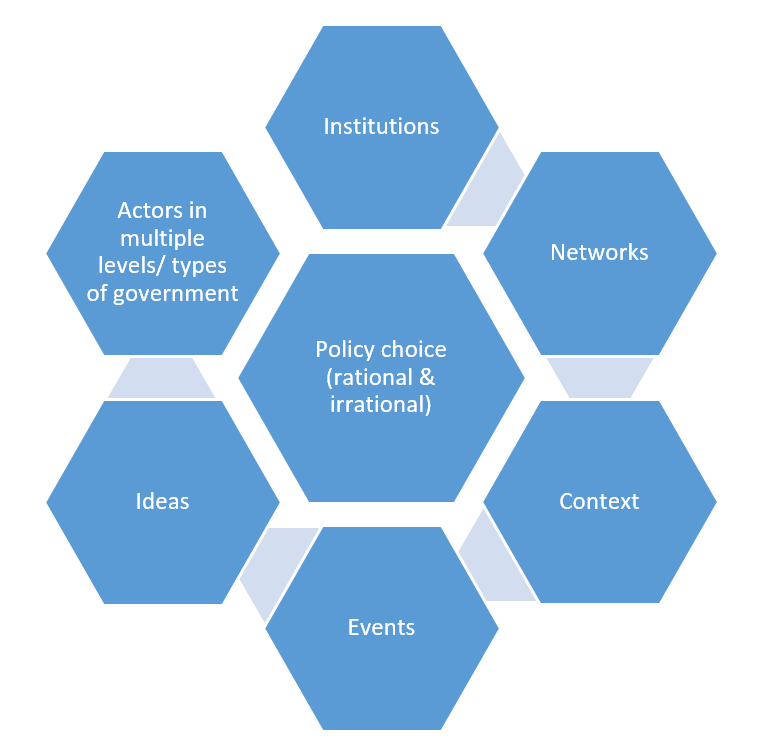This post begins by reproducing Can you separate the facts from your beliefs when making policy?(based on the 1st edition of Understanding Public Policy) …
A key argument in policy studies is that it is impossible to separate facts and values when making policy. We often treat our beliefs as facts, or describe certain facts as objective, but perhaps only to simplify our lives or support a political strategy (a ‘self-evident’ fact is very handy for an argument). People make empirical claims infused with their values and often fail to realise just how their values or assumptions underpin their claims.
This is not an easy argument to explain. One strategy is to use extreme examples to make the point. For example, Herbert Simon points to Hitler’s Mein Kampf as the ultimate example of value-based claims masquerading as facts. We can also identify historic academic research which asserts that men are more intelligent than women and some races are superior to others. In such cases, we would point out, for example, that the design of the research helped produce such conclusions: our values underpin our (a) assumptions about how to measure intelligence or other measures of superiority, and (b) interpretations of the results.
‘Wait a minute, though’ (you might say). “What about simple examples in which you can state facts with relative certainty – such as the statement ‘there are X number of words in this post’”. ‘Fair enough’, I’d say (you will have to speak with a philosopher to get a better debate about the meaning of your X words claim; I would simply say that it is trivially true). But this statement doesn’t take you far in policy terms. Instead, you’d want to say that there are too many or too few words, before you decided what to do about it.
In that sense, we have the most practical explanation of the unclear fact/ value distinction: the use of facts in policy is to underpin evaluations (assessments based on values). For example, we might point to the routine uses of data to argue that a public service is in ‘crisis’ or that there is a public health related epidemic (note: I wrote the post before COVID-19; it referred to crises of ‘non-communicable diseases’). We might argue that people only talk about ‘policy problems’ when they think we have a duty to solve them.
Or, facts and values often seem the hardest to separate when we evaluate the success and failure of policy solutions, since the measures used for evaluation are as political as any other part of the policy process. The gathering and presentation of facts is inherently a political exercise, and our use of facts to encourage a policy response is inseparable from our beliefs about how the world should work.
… It continues with an edited excerpt from p59 of Understanding Public Policy, which explores the implications of bounded rationality for contemporary accounts of ‘evidence-based policymaking’:
‘Modern science remains value-laden … even when so many people employ so many systematic methods to increase the replicability of research and reduce the reliance of evidence on individual scientists. The role of values is fundamental. Anyone engaging in research uses professional and personal values and beliefs to decide which research methods are the best; generate research questions, concepts and measures; evaluate the impact and policy relevance of the results; decide which issues are important problems; and assess the relative weight of ‘the evidence’ on policy effectiveness. We cannot simply focus on ‘what works’ to solve a problem without considering how we used our values to identify a problem in the first place. It is also impossible in practice to separate two choices: (1) how to gather the best evidence and (2) whether to centralize or localize policymaking. Most importantly, the assertion that ‘my knowledge claim is superior to yours’ symbolizes one of the most worrying exercises of power. We may decide to favour some forms of evidence over others, but the choice is value-laden and political rather than objective and innocuous’.
Implications for policy analysis
Many highly-intelligent and otherwise-sensible people seem to get very bothered with this kind of argument. For example, it gets in the way of (a) simplistic stories of heroic-objective-fact-based-scientists speaking truth to villainous-stupid-corrupt-emotional-politicians, (b) the ill-considered political slogan that you can’t argue with facts (or ‘science’), (c) the notion that some people draw on facts while others only follow their feelings, and (d) the idea that you can divide populations into super-facty versus post-truthy people.
A more sensible approach is to (1) recognise that all people combine cognition and emotion when assessing information, (2) treat politics and political systems as valuable and essential processes (rather than obstacles to technocratic policymaking), and (3) find ways to communicate evidence-informed analyses in that context. This article and 750 post explore how to reflect on this kind of communication.
Most relevant posts in the 750 series
Linda Tuhiwai Smith (2012) Decolonizing Methodologies
Carol Bacchi (2009) Analysing Policy: What’s the problem represented to be?
Deborah Stone (2012) Policy Paradox
Who should be involved in the process of policy analysis?
William Riker (1986) The Art of Political Manipulation
Using Statistics and Explaining Risk (David Spiegelhalter and Gerd Gigerenzer)
Barry Hindess (1977) Philosophy and Methodology in the Social Sciences
See also
To think further about the relevance of this discussion, see this post on policy evaluation, this page on the use of evidence in policymaking, this book by Douglas, and this short commentary on ‘honest brokers’ by Jasanoff.





















 c
c









